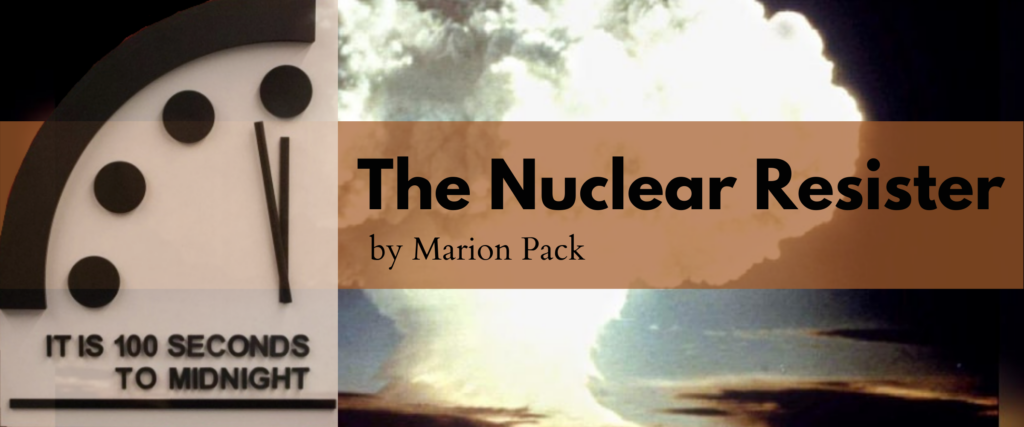
Nuclear Resister #8: June 29, 2021
Tri-Valley CAREs’ Analysis of the National Nuclear Security Administration’s Fiscal Year 2022 Budget Request, Part One…
Careening Over the Nuclear Precipice:
New Warheads in the First Biden Budget
Over the course of four years, the Trump Administration increased funding for the National Nuclear Security Administration (NNSA) to redesign nuclear weapons by a whopping 50%, resulting in less money for domestic programs on the one hand and the escalation of a perilous global arms race on the other.
Now these decisions belong to a new President, Joe Biden. Granted, he has a lot on his plate. Still weapons of nuclear mass destruction capable of ending life as we know it in a single afternoon should command serious attention. President Biden has promised a new nuclear posture review, to begin soon. Yet his first budget request to Congress continues the dangerous arms racing of his predecessor. All of the new warheads in the Trump posture review and budgets are fully funded in the fiscal 2022 request. Further, a city destroying, megaton-class bomb whose planned retirement was blocked by Trump gets a Biden infusion to keep it in the stockpile.
The Biden budget request went to Congress on Friday, May 27, 2021. The Department of Energy and its NNSA did not post the budget book containing the warhead numbers until late that evening, around 7pm. In media parlance, when a government agency does that it’s called “taking out the trash,” which means making an announcement at a time not likely to be noticed – such as late on Friday before a holiday weekend. Worse, some of the Department’s budget books are still not posted as of today (Saturday), including the volume detailing Livermore Lab’s budget.
In this analysis, we offer insights into the funding to develop three dangerous, wrongheaded new warheads: the W87-1 to sit atop a new land-based ICBM, the W93 to be coordinated with the UK, and a warhead based on a still-evolving air-launched cruise missile design that will be launched from attack subs and, perhaps, surface ships. We will also cover some NNSA top line numbers and the money to sustain the B83 in the arsenal.
Top Line: Priority Change Needed
The fiscal 2022 request for the NNSA is $19.7 billion, a small increase of about $11 million over the current fiscal year. However, this request is nearly $3 billion above the fiscal 2020 request, which in turn was higher than in fiscal 2019, and so on. Tri-Valley CAREs had hoped to see the Biden budget truly trim the excess and not merely tweak the amount of increase.
Within NNSA, the lion’s share of the budget is for the line item called nuclear Weapons Activities. The fiscal 2022 request contains $15.5 billion for this single line item. Weapons Activities is the budget line that funds new warheads and the bomb plants to produce them. Notice that $15.5 billion subtracted from $19.7 billion leaves only a tad over $4 billion for the rest of NNSA including Defense Nuclear Nonproliferation, which gets about $2.3 billion. A change in priorities is needed.
The W87-1: Costly and Dangerous
This will be the first new-design warhead with wholly new components to be developed since end of the Cold War and the cessation of nuclear explosive testing in Nevada. It is intended to replace the W78, and will sit atop a new ICBM, called the Ground Based Strategic Deterrent (GBSD) missile. The W87-1 is a main driver for expanded plutonium pit production because it is being designed with a novel core that will require new pit production.
A recent Government Accountability Office (GAO) report detailed serious problems with this warhead and pegged its cost and desired features at about $15 billion. Cost overruns are likely to add billions more.
The Biden budget offers this new warhead program more than $690 million for fiscal 2022. This is precisely the same amount that the Trump budget had projected. No cut here. It’s also about $150 million more than fiscal 2021, an increase of nearly 28%. According to the Biden budget, this funding boost will allow the W87-1 to move into “Development Engineering” (called phase 6.3).
The budget contains a number of passages that hint at how truly novel this warhead is. To cite one example, the W87-1 certification rests on a whole new suite of technologies called “Enhanced Capabilities for Subcritical Experiments (ECSE).”
Subcritical tests are conducted in underground chambers at the Nevada Nuclear Security Site, previously known as the Nevada Test Site where more than a thousand above and below ground full-scale nuclear tests were detonated before 1992. Subcritical experiments use weapons grade plutonium but the small amounts involved do not reach a self-sustaining “critical” fission chain reaction, or nuclear explosive yield. They may, however, go up to that bloody edge.
ECSE is intended to increase the diagnostics capabilities for these tests – and to allow more of them to occur. According to the budget request, the W87-1 will require ECSE and include at least one subcritical nuclear test as part of its certification. One concern of Tri-Valley CAREs’ is that if there are certification difficulties due to the novel nature of the W87-1 it will increase pressure to conduct a yield-producing nuclear explosive test, an event that would lead to other nuclear-armed states, including Russia, China, India and Pakistan, quickly following suit. The escalation of nuclear dangers in that event cannot be overstated. This warhead development scheme should not move forward.
The W93: For What Purpose?
This is a new-design submarine-launched warhead that lacks justification. U.S. nuclear class submarines patrol with two designs, and both have been upgraded recently. The W93 was not funded until fiscal 2021, when it received $53 million for initial studies. The Biden budget contains $72 million for the W93, an increase of $19 million or nearly 36%.
We can’t talk about the W93 without discussing the UK. The United Kingdom’s nuclear capability contains a single sub-launched design based on a U.S. warhead. Recently, the UK announced plans to increase the “ceiling” for its stockpile. Tri-Valley CAREs has questioned the extent to which the UK’s needs underlie the sudden plan for NNSA to create this new W93 warhead.
The fiscal 2022 budget request contains some interesting answers to our question. In discussing the W93 Concept Assessment, the budget states that the UK “is participating as observers in the US W93/Mk7 warhead program.” And, in the subsequent budget section subtitled Stockpile Major Modification, it states U.S. weapons designers will “coordinate with the UK on their Replacement Warhead.” This begs the question of why U.S. taxpayers are funding this warhead.
Moreover, the U.S. and the UK are bound by the Non-Proliferation Treaty, which prohibits this kind of nuclear sharing. While there is a bit of complicated history here, one has to ask if this latest collaboration in the W93 program goes beyond the pale. The W93 should be abandoned.
The SLCM Warhead: Cold War Redux
This new warhead is a product of the Trump nuclear posture review of 2018, which proposed bringing back nuclear-armed sea-launched cruise missiles (SLCMs). This weapon type was removed from service and placed into storage by President George H.W. Bush circa 1991. In the decades since U.S. attack subs and surface ships have carried conventional, but not nuclear, weapons – and the old SLCM warhead has been retired.
While a new nuclear SLCM concept was studied in the closing months of the Trump Administration, a wholly new warhead for this old Cold War mission shows up in the Biden budget as the W80-4 ALT-SLCM. The designation W80-4 means that this new warhead will be based on the design chosen for a new air-launched cruise missile capability, which is still under development at NNSA. The Biden budget allots $10 million to jumpstart development the W80-4ALT-SLCM rather than cancel it altogether as a bad idea inherited from the prior administration.
The B83: New Money for an Old Relic
The B83 is the last U.S. megaton-class nuclear bomb, certified to have a variable (adjustable) yield of up to 1.2 megatons. One megaton is the explosive equivalent of one million tons of TNT. This Cold War relic was developed in the late 1970s and put in the stockpile in 1983. Until Trump’s nuclear posture review changed its course, the B83 had been slated for retirement.
Without explanation, the Biden budget request includes “sustainment” funding to keep the B83 in the stockpile at a cost of more than $98 million in fiscal 2022. The budget specifies that to extend its service life the B83 will require two alterations (Alt 753 and Alt 353) during the fiscal year – specifically for a new neutron generator and a new tritium (radioactive hydrogen) reservoir, respectively. Instead, these funds should be used to retire this bomb.
Conclusion
These nuclear weapons are but one part of a so-called “modernization” scheme to redesign and rebuild the entire U.S. nuclear weapons stockpile, including warheads, production plants and delivery vehicles, i.e., missiles, planes and ships. The overall financial cost over 30-years will be upwards of $2 trillion (and more if you count likely cost overruns).
Last week the Congressional Budget Office released its revised near-term cost estimate for “modernization.” The CBO report stated that the costs have risen $140 billion, or 28%, to $494 billion for the 2019 to 2028 timeframe that CBO originally studied. It’s notable that this steep rise has occurred in the single year since the last CBO report. What does it portend for the coming 30-years?
Moreover, the direct financial costs of U.S. nuclear weapons do not tell the whole story. Included in this story are the costs to communities when health care and other needs go unmet. (For example in this pandemic U.S. nuclear weapons did not save a single life – nor will they in the next similar crisis.)
Nor can dollars alone account for the proliferation costs of U.S. nuclear weapons. These costs may be extreme. As Tri-Valley CAREs celebrates the entry into force this year of the Treaty on the Prohibition of Nuclear Weapons and promotes its vision, we note too that U.S. nuclear “modernization” spending has helped catalyze each of the other nuclear-armed states to upgrade its nuclear capabilities too.
Our global, and domestic, future hangs in the balance. If the Biden Administration wants to “Build Back Better” following Covid-19, it must not blindly retain the Trump nuclear policies and budgets. Presidential attention is needed now. The announcement of a new nuclear posture review to be undertaken in the future is welcome, but the NNSA’s nuclear weapons budget request that has just been released is where the “rubber” of U.S. policy meets the “road” of new warheads and new dangers. The NNSA weapons budget must be cut now.
Note: This is Tri-Valley CAREs’ fiscal 2022 budget analysis part one. Part two will cover the NNSA’s new bomb plants, with a focus on expanded plutonium pit production and other new weapons complex infrastructure schemes. Part three will cover the fiscal 2022 budget request for Livermore Lab in detail.
Stay tuned. And do use the information we offer to accelerate your advocacy.
